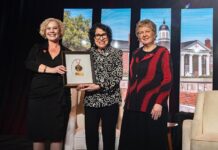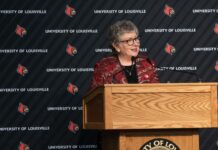That’s how much garbage the University of Louisville kept out of landfills in 2010 through ramped-up efforts to recycle and reuse materials on campus, according to a report recently filed with the state.
The university reduced the weight of its trash by 996,000 pounds last year, an amount measuring about 10,000 cubic yards. Put another way, UofL recycled 48 percent of all the solid waste it produced, a gain of 3 percent over 2009.
Some 29,000 pounds of glass and 20,000 pounds of plastic were among the recycled materials, a net gain of 49,000 pounds because UofL recycled neither before 2010.
The amount of recycled aluminum rose from 6,100 to 12,500 pounds, and the amount of recycled paper and cardboard—65,000 pounds and 204,000 pounds respectively—reached an all-time high.
On top of helping the environment, the extra recycling saved UofL $10,000 in landfill charges, said recycling coordinator Aaron Boggs.
A single-stream recycling effort launched early last year and a strong commitment to recycling by the offices that keep campus operating factored into the increase, Boggs said.
“Single-stream recycling is doing exactly what we hoped it would do. At first, some people worried it might lead to bug problems, or that drains might clog up when people rinsed stuff out in the sink. But we haven’t seen that at all.”
Starting last February, people at UofL began discarding paper, cardboard, plastic, aluminum and glass into a single bin. Physical Plant workers have been collecting the mixed material and sending it to a private company in New Albany for sorting and recycling.
Food waste and other non-recyclable garbage now goes into a personal green mini-bin about the size of a coffee can that people are responsible for emptying themselves.
More than 4,000 mini-bins have been distributed since single-stream recycling began and all but a few campus buildings are now on board with the program, Boggs said.
Not only are people recycling more on a personal basis, but a growing number of UofL offices such as Physical Plant, Information Technology and Planning, Design and Construction are regularly recycling materials on a mass scale, he said.
For example, the university recycled 200,000 pounds of scrap metal, 40,000 pounds of e-scrap and 18,000 pounds of batteries. Another 240,000 pounds of lamps and ballasts were recycled through UofL’s performance contract with Siemens Building Technologies Inc. to make campus more energy efficient.
In the past, UofL has recycled as much as 300,000 pounds of coal ash a year. However, the university plans to stop burning coal by 2015 and did not burn any this winter, said Larry Detherage, associate vice president for facilities.
Programs encouraging faculty, staff and students to share used goods with others on campus also are helping cut back UofL’s waste.
A swap shop in April allowed people to trade old clothing, office supplies, books and DVDs, while an online surplus property exchange helped employees find or give away computers and appliances. The university’s environmental health and safety office even offers a program that allows researchers to share chemicals.
This winter, UofL joined a group of more than 600 colleges and universities participating in Recyclemania, a “friendly” competition to promote waste reduction, said Justin Mog, associate provost for sustainability initiatives. The competition runs through April 2.
“Our students aren’t the only ones turning into Recyclemaniacs,” Mog said. “Faculty and staff are too. We have a good chance of becoming the recycling champion of all public universities in Kentucky.”
Boggs hopes to further reduce the amount UofL throws away this year by converting some of the university’s outdoor trash cans to recycling bins.
“When it comes to recycling and reusing, the sky’s the limit,” he said.


























